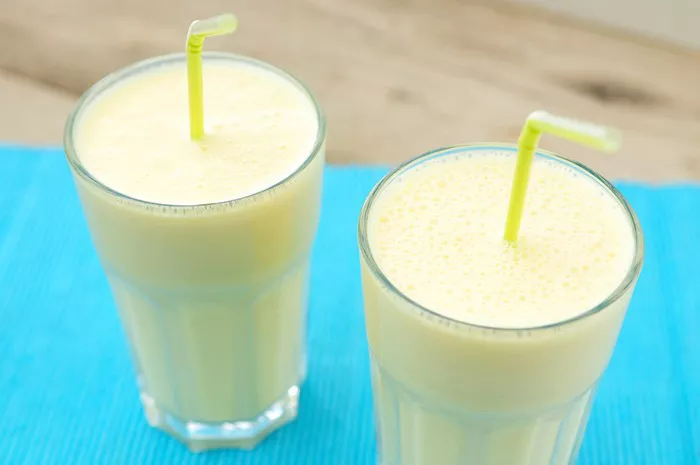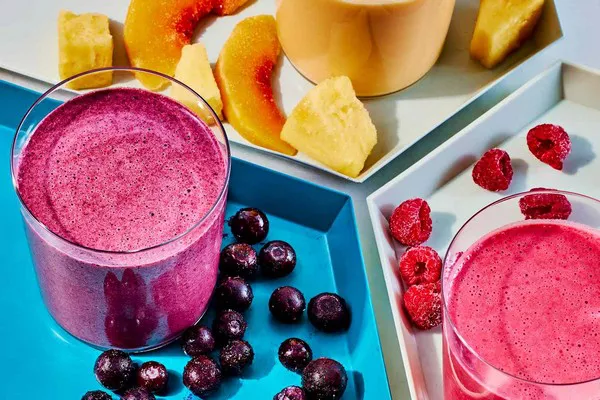Smoothies are a quick, easy, and delicious way to boost your nutrition. They can be made for breakfast, a snack, or even as a meal replacement. The beauty of smoothies is that they are highly customizable. You can mix and match ingredients to suit your tastes and dietary needs. In this article, we’ll explore the essential elements of a smoothie, offer suggestions for different types of ingredients, and provide tips for creating your perfect blend.
1. The Basic Components of a Smoothie
To create a smoothie, you need a few basic components: a liquid base, fruits and vegetables, a thickener, and optional extras to boost nutrition or flavor. Let’s break these down into easy-to-understand categories.
Liquid Base
The liquid base is the foundation of your smoothie. It helps blend the ingredients together and determines the texture of your smoothie. Here are some common liquid options:
Water: If you’re aiming for a low-calorie or light smoothie, water is a simple choice. It won’t add flavor but keeps your smoothie hydrating and refreshing.
Milk: Dairy milk adds creaminess and protein. It also makes your smoothie more filling, which is ideal if you’re using it as a meal replacement.
Plant-based milks: Almond, soy, oat, or coconut milk are excellent alternatives to dairy milk. Each has its own unique flavor and nutrient profile.
Juice: Fruit juices like orange, apple, or pineapple add sweetness and flavor, but be mindful of the sugar content.
Coconut water: Coconut water is hydrating and adds a mild, sweet flavor. It’s also rich in electrolytes, making it perfect for a post-workout smoothie.
SEE ALSO: How Can I Make a Healthy Smoothie?
Fruits
Fruits are the most common ingredient in smoothies. They provide natural sweetness, vitamins, and antioxidants. Here are some popular fruits to include:
Bananas: Bananas give smoothies a creamy texture and natural sweetness. They are also high in potassium.
Berries: Strawberries, blueberries, raspberries, and blackberries are rich in antioxidants, fiber, and vitamins. They also add a burst of color.
Mango: Mangoes add tropical flavor and a creamy consistency to smoothies.
Pineapple: Pineapple gives a sweet and tangy taste while adding a dose of vitamin C.
Apples and pears: These fruits provide fiber and a mild sweetness, perfect for a more neutral smoothie.
Avocado: Avocado is technically a fruit and adds creaminess without much flavor. It’s high in healthy fats and perfect for making your smoothie more filling.
Vegetables
Adding vegetables to smoothies is a great way to increase your daily intake of nutrients without sacrificing flavor. Some veggies blend seamlessly into smoothies:
Spinach: Spinach is one of the most popular vegetables for smoothies because it’s mild in flavor and loaded with vitamins A, C, and K.
Kale: Kale is another nutrient-dense green, though it has a stronger flavor than spinach. It adds fiber, iron, and calcium.
Carrots: Carrots add a subtle sweetness and are rich in beta-carotene, which is great for eye health.
Cucumber: Cucumbers are light and refreshing. They add hydration and a mild flavor.
Zucchini: Zucchini blends easily into smoothies and adds fiber and vitamins without altering the flavor much.
Cauliflower: Frozen cauliflower may sound unusual, but it adds creaminess to smoothies without changing the taste. It’s also low in calories and high in fiber.
2. Thickeners for a Creamy Texture
To achieve that smooth, thick consistency we all love, you’ll need to add something creamy. Here are some great options:
Greek Yogurt
Greek yogurt is a common thickener for smoothies. It’s packed with protein, which helps keep you full longer, and adds a creamy texture without being too heavy. It also provides probiotics for gut health.
Nut Butters
Peanut butter, almond butter, and cashew butter add a rich, creamy texture to smoothies. They are also excellent sources of healthy fats and protein, making your smoothie more filling.
Oats
Adding a handful of rolled oats to your smoothie is a great way to boost the fiber content. Oats also create a thicker, heartier texture.
Chia Seeds and Flaxseeds
Chia seeds and flaxseeds are packed with omega-3 fatty acids and fiber. When soaked in liquid, they swell and create a gel-like consistency, making them perfect for thickening smoothies.
Frozen Fruit
Frozen fruit is an easy way to add thickness without ice. Bananas, berries, mango, or peaches, when frozen, give your smoothie a creamy, frosty texture.
3. Sweeteners: Naturally Boosting the Sweetness
While fruits provide natural sweetness, sometimes you might want to add a little more sweetness to your smoothie. Here are some healthy sweeteners:
Honey
Honey adds natural sweetness and contains antioxidants. A teaspoon or two is enough to enhance the flavor without overwhelming the other ingredients.
Maple Syrup
Maple syrup is another natural sweetener with a rich flavor. It works well in smoothies with warm spices or nut butters.
Dates
Dates are naturally sweet and contain fiber. They blend well into smoothies, adding a caramel-like sweetness. Just a couple of dates can elevate your smoothie’s flavor.
Stevia
If you’re looking for a calorie-free sweetener, stevia is a plant-based option. A little goes a long way, so start with a small amount.
4. Add Protein for a Balanced Smoothie
If you want your smoothie to keep you fuller for longer, adding a protein source is a great idea. Here are some protein-rich additions:
Protein Powder
Protein powder is a convenient way to add protein to your smoothie, especially if you’re using it as a meal replacement or post-workout snack. Choose from whey, pea, hemp, or soy protein powders depending on your dietary needs.
Greek Yogurt
As mentioned earlier, Greek yogurt not only thickens your smoothie but also adds a significant protein boost.
Tofu
Silken tofu blends easily into smoothies, adding protein and a creamy texture without much flavor. It’s a great option for vegans or those avoiding dairy.
Cottage Cheese
Cottage cheese may seem like an unusual smoothie ingredient, but it adds creaminess and a substantial amount of protein. Its mild flavor pairs well with fruits.
5. Superfoods: Boosting Nutrition
Superfoods are nutrient-dense ingredients that can give your smoothie an extra health boost. Here are some popular superfoods to include:
Chia Seeds
Chia seeds are packed with omega-3 fatty acids, fiber, and protein. They expand when soaked in liquid, making them great for thickening smoothies while adding nutrients.
Flaxseeds
Ground flaxseeds are a rich source of omega-3s and fiber. They blend well into smoothies, and their mild flavor won’t overpower the other ingredients.
Spirulina
Spirulina is a blue-green algae that’s incredibly rich in vitamins, minerals, and protein. Just a small amount adds a vibrant green color and a nutritional boost.
Maca Powder
Maca is a root vegetable native to the Andes. It’s known for its energy-boosting properties and slightly nutty flavor, making it a great addition to smoothies.
Acai Powder
Acai is a tropical berry rich in antioxidants. Acai powder adds a deep purple color and a tangy flavor to your smoothie, along with its health benefits.
6. Flavor Enhancers and Spices
Sometimes, a smoothie needs just a little extra flavor. Here are some options to enhance the taste of your smoothie:
Vanilla Extract
A dash of vanilla extract adds a warm, sweet flavor that pairs well with most smoothie ingredients.
Cinnamon
Cinnamon adds warmth and a touch of spice to smoothies. It works especially well with nut butters, bananas, or oats.
Cocoa Powder
For chocolate lovers, unsweetened cocoa powder is a great way to add rich flavor without added sugar. It’s full of antioxidants and pairs well with bananas, berries, and nut butters.
Fresh Herbs
Mint, basil, or cilantro can add a unique twist to your smoothie. They bring fresh, bright flavors that complement fruits like berries or citrus.
7. Ice or Frozen Ingredients
If you prefer a frosty, refreshing smoothie, adding ice or using frozen ingredients is key. Frozen fruits like bananas, berries, or mangoes create a thick, cold texture without diluting the flavor. Ice can be used to achieve a lighter, slushier consistency.
8. Final Tips for the Perfect Smoothie
Balance your flavors: Make sure you have a balance of sweet, creamy, and fresh ingredients. For example, pair sweet fruits like bananas or mango with more neutral greens like spinach or kale.
Don’t overdo it: While it’s tempting to pack your smoothie with many ingredients, keeping it simple often results in a better taste and texture.
Experiment with ratios: Adjust the amount of liquid based on how thick or thin you like your smoothie. If it’s too thick, add more liquid. If it’s too thin, add more frozen fruit or a thickener like yogurt or oats.
Conclusion
Smoothies are incredibly versatile and can be tailored to meet your personal preferences and nutritional needs. Whether you’re looking for a quick breakfast, a post-workout refuel, or a nutritious snack, knowing what to put in a smoothie ensures you get the most out of every sip. Start with a liquid base, add your favorite fruits and vegetables, thicken it up with yogurt or frozen ingredients, and enhance the flavor with natural sweeteners, superfoods, or spices. The possibilities are endless, and the results are always delicious!
Related topics:























